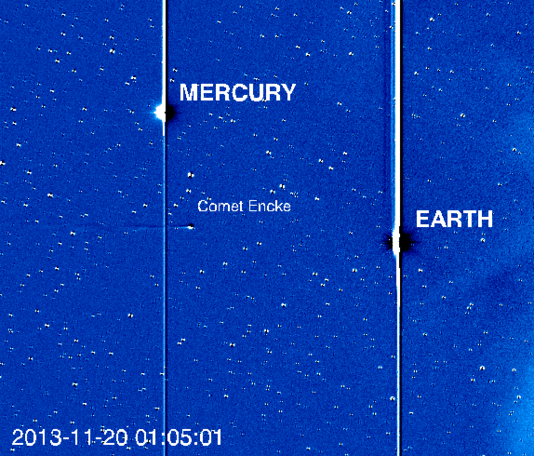As comets ISON and Encke continue toward their respective rendezvous with the Sun, they have now both been captured on camera by NASA’s solar-observing STEREO spacecraft. The image above, taken on Nov. 21 (UT) with STEREO-A’s high-resolution HI-1 camera, shows ISON as it enters the field of view from the left. Encke is at center, while the planets Mercury and Earth (labeled) are bright enough to cause vertical disruptions in the imaging sensors. (The Sun is off frame to the right.)
As cool as this image is, it gets even better: there’s a video version. Check it out below:

The dark “clouds” coming from the right are density enhancements in the solar wind, causing all the ripples in comet Encke’s tail. (Source)

It’s fascinating to watch how the solar wind shapes and affects the tail of comet Encke… as ISON moves further into view, I’m sure we’ll see similar disruptions in its tail as well. (And look what STEREO-A saw happen to Encke’s tail back in 2007!)
Encke reached the perihelion of its 3.3-year-long orbit on Nov. 21; newcomer ISON will arrive at its on Nov. 28. While it seems to be holding together quite well in these STEREO images, what happens when it comes within 730,000 miles of the Sun next week is still anybody’s guess.


The comets look like sperms racing towards the ovum!
Panspermia!
STEREO-A HI2 view of four comets (ISON, Encke, Lovejoy & Nevski) from Nov. 10-14: http://stereo.gsfc.nasa.gov/news/FourComets.shtml
Is ISON destined to ever return? Has it’s orbit been determined? If ISON breaks up and is still a cosmic asteroid cluster, would there be any possibility of a planetary collision upon such a return?
No. Because even when it breaks up, the parts move in the same orbit.
Mass have no effect on the orbit of a comet. The orbit is the same even if it loses half of its mass.
And no it will never return. It moves too fast to ever return.
And even if somehow it gets back in an elliptical orbit, the speed would makes it still millions of year to get back to Earth.